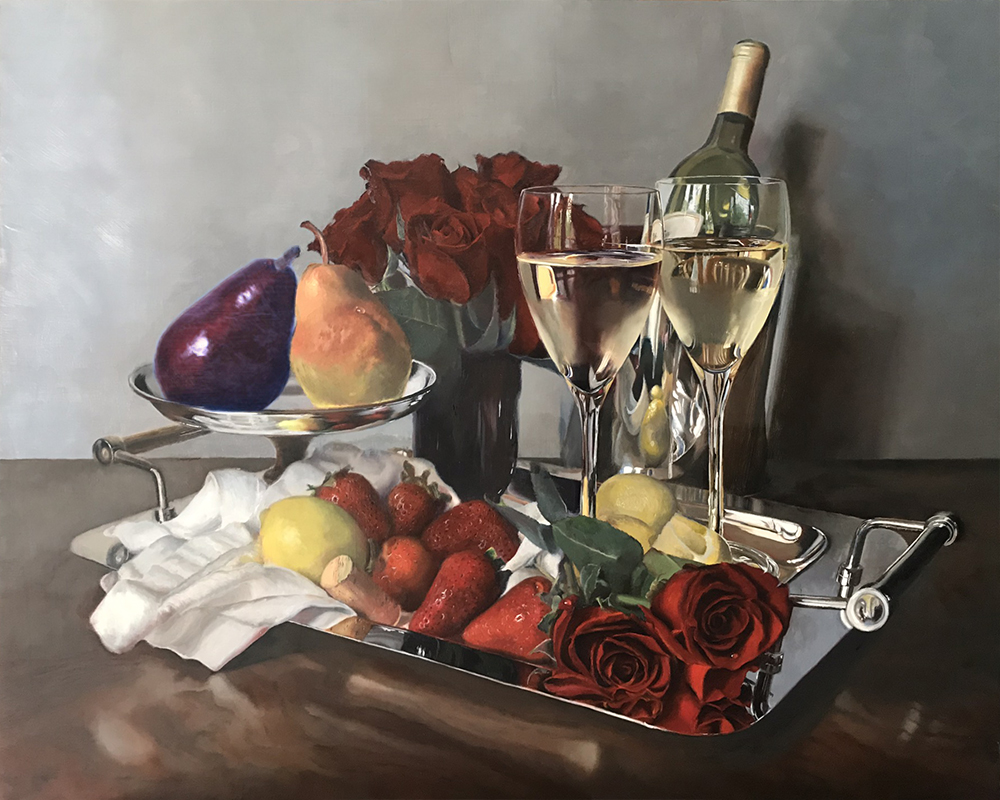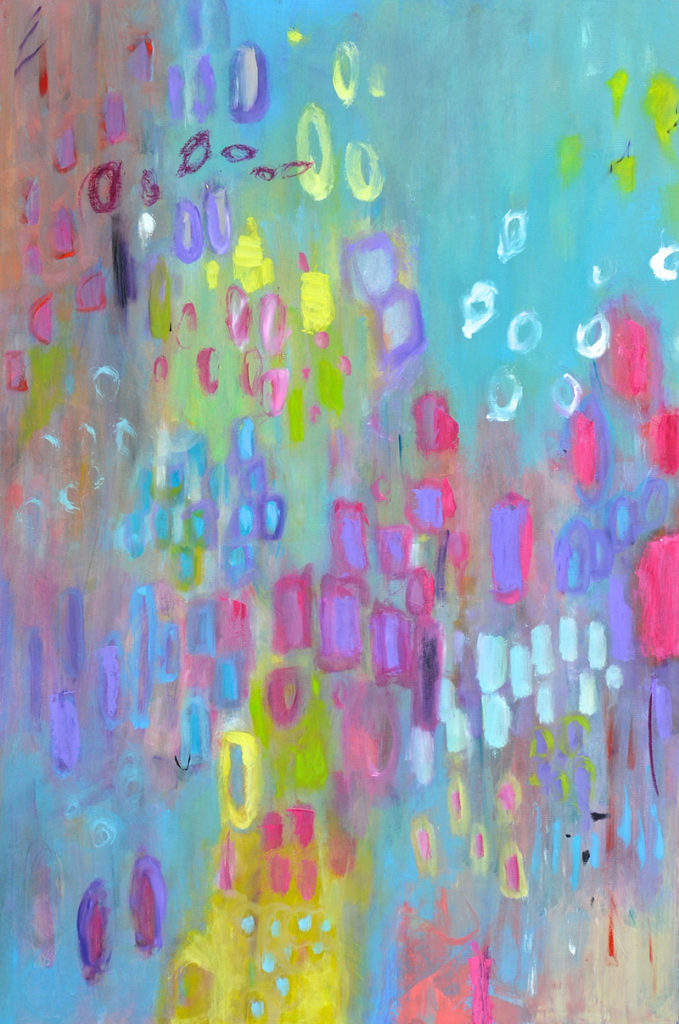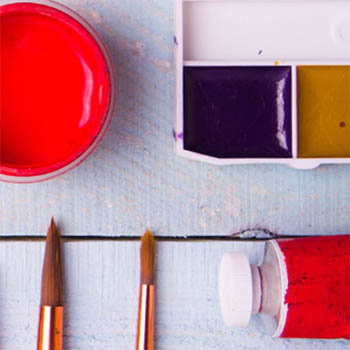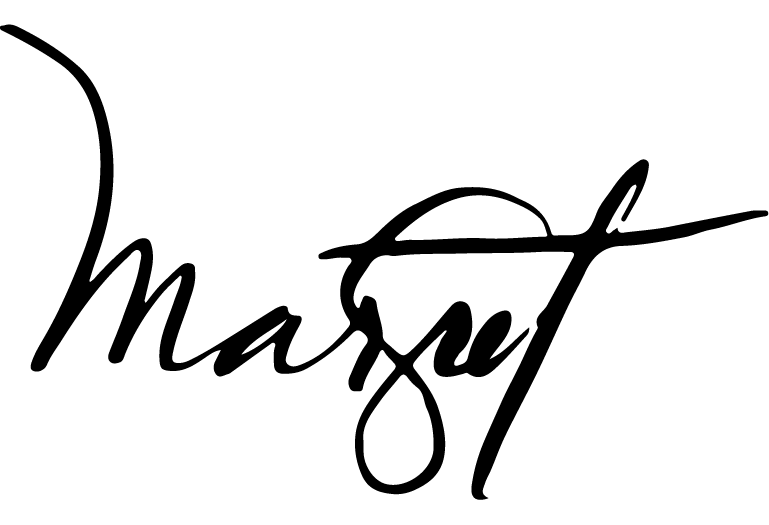
Tête-à-Tête: Chardonnay with Roses and Fruit, oil on panel, 30″x24″, by Margret McDermott
This past spring I listened to the book, “Joyful,” by Ingrid Fetell Lee on my daily walks. Lee is a designer who found that certain aesthetic elements, like bright color, abundance, and round shapes, are universally joyful. It explains why things like handfuls of confetti thrown into the air, fountains of fireworks exploding overhead, and candles on a sprinkle-topped cake spark joy in our hearts.
Scientists have found that people who experience joy tend to live longer and healthier, more stress-free, lives. “Extant research suggests that being happy may be associated with better health and longevity.” I would argue that artwork that exhibits these aesthetic elements create joy and happiness in both the artist and art lover alike and this leads to increased health and longevity.
In painting over the years, I have often thought about which elements bring forth a positive emotional response, specifically, joy. One of my painting instructors, Todd Burroughs, had a short list of elements that people respond well to: bright white objects, reflective metal objects, and reflective glass objects. I add to that list two things that bring joy to me personally: bright colors set against darker low-key objects and abstracted reflections.
My new painting, which I started over a year ago and abandoned for a time, is a still-life with wine glasses, roses, and fruit that incorporates all of these elements by design. As each object was completed, my feeling of joy in seeing it on my easel increased.
I have occasionally moved off to other artistic pursuits, such as painting landscapes and figurative work. Each of those has its appeal and opportunities for introducing elements of joy, but still life, for me, is a treasure trove of possibilities in which to distill and focus on these joyful aspects. Reading Joyful in parallel to painting this still life was wonderfully validating and gave me insight into why I am drawn to creating this type of painting. Creating them brings me joy, and when I feel more joyful, I feel less stressful and fatigued. This was especially important as I worked on this painting during height of the Covid-19 quarantine.

During this time, I saw posts on Instagram of new paintings from my artist friend, Amy Fell, who studied with Todd Burroughs a few years before I did. Her paintings are typically in the contemporary realist style depicting everyday objects with equal parts nostalgia and humor, often against brightly colored, whimsically patterned wallpaper. With the field of daisies, showing abundance, and bright colors, you can see that the painting shown above, “Princess,” wholeheartedly embraces the elements of joy.
What caught my attention in the new posts was the complete shift to abstract painting. The new paintings show bright, shifting fields of color overlaid with loosely formed circles and rectangles. Again, the painting incorporates the elements of joy, but in an entirely different way.

I asked Amy what motivated the change. She told me about her recent battle with a debilitating autoimmune disease that had kept her away from painting. She struggles with managing pain and has learned to accept “that [it] can’t really be controlled, but with determination, can be accepted.” She said that her realist paintings “require hours of labor and deep concentration, both of which I am still not consistently capable of. Still, I am a painter at heart and I find great joy in color. I started to think maybe a meticulous rendering is not something I must always create in order to feel happy about my art.” Amy decided to “embrace the loss of control over [her] life” and give herself over to the intuitive application of paint in an abstract way.
“I find so much joy and pleasure when I am working on these abstract pieces, which are filled with color, movement and most important, an intentional loss of control.”
As the study I mentioned says, “Happy people typically enjoy better health outcomes because they demonstrate more successful adaptation.” Amy adapted to her situation and found a way to incorporate the elements of joy found in her realist work into her new abstract work, contributing to her healing and a return to the work she loves.
In looking at my still life paintings and Amy’s experience we see that while certain aesthetic elements of artwork can bring joy and healing to the viewer, the artist also benefits from the creation of the same artwork. This joyful communion makes art an essential part of the sustained health and wellbeing of humanity.
I would add that you do not have to be a professional artist to benefit from the creation of joyful objects. There are many opportunities for bringing joyful objects into your life. Collecting shells on the beach or feathers on a walk. Watching colorful birds out of your window. Crafting with colorful beads or knitting or crocheting colorful yarn. Coloring in adult coloring books. Decorating with beaded and embroidered pillows. Planting a beautiful garden. Waving sparklers with the kids on the 4th of July. And, of course, collecting artwork. The possibilities are endless.
| I wish you much joy wherever you find it, as well as health, and a long and luscious life. Yours, Margret |

Try It…
Check out the DailyOM class, “Meditative Painting to Heal Your Life.” You just may find your joyful place.
